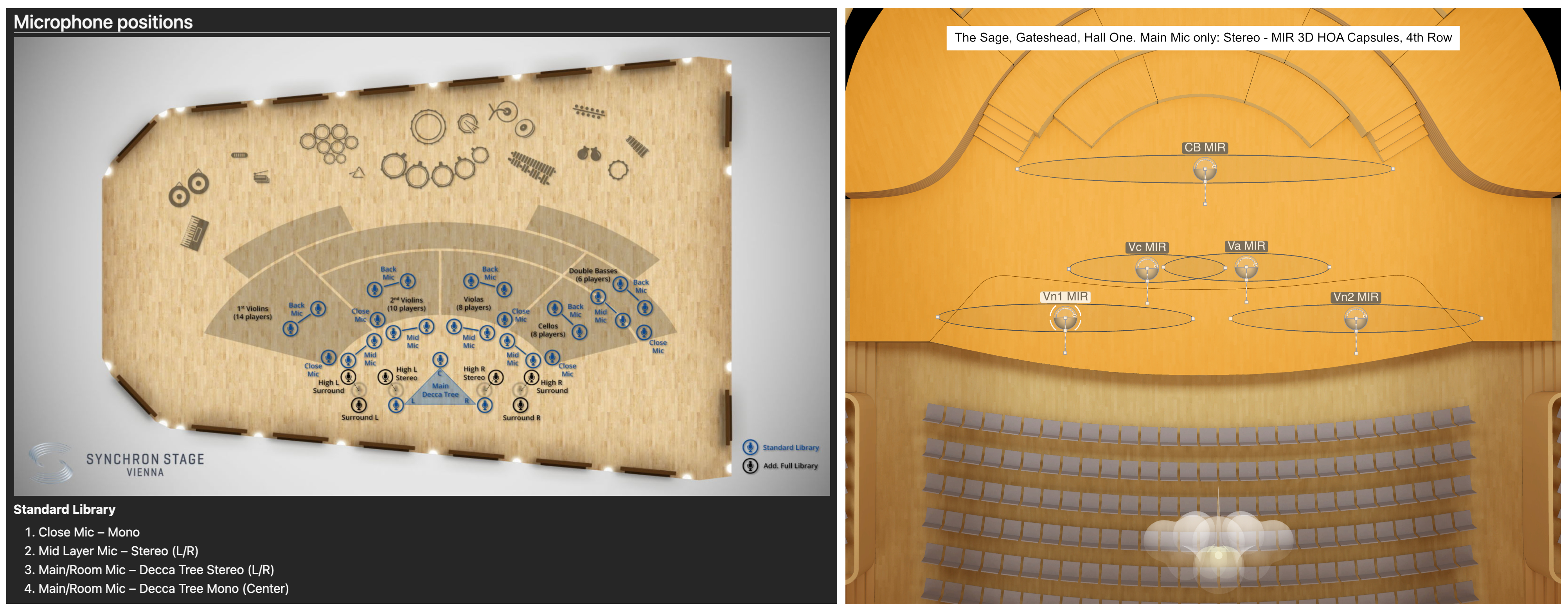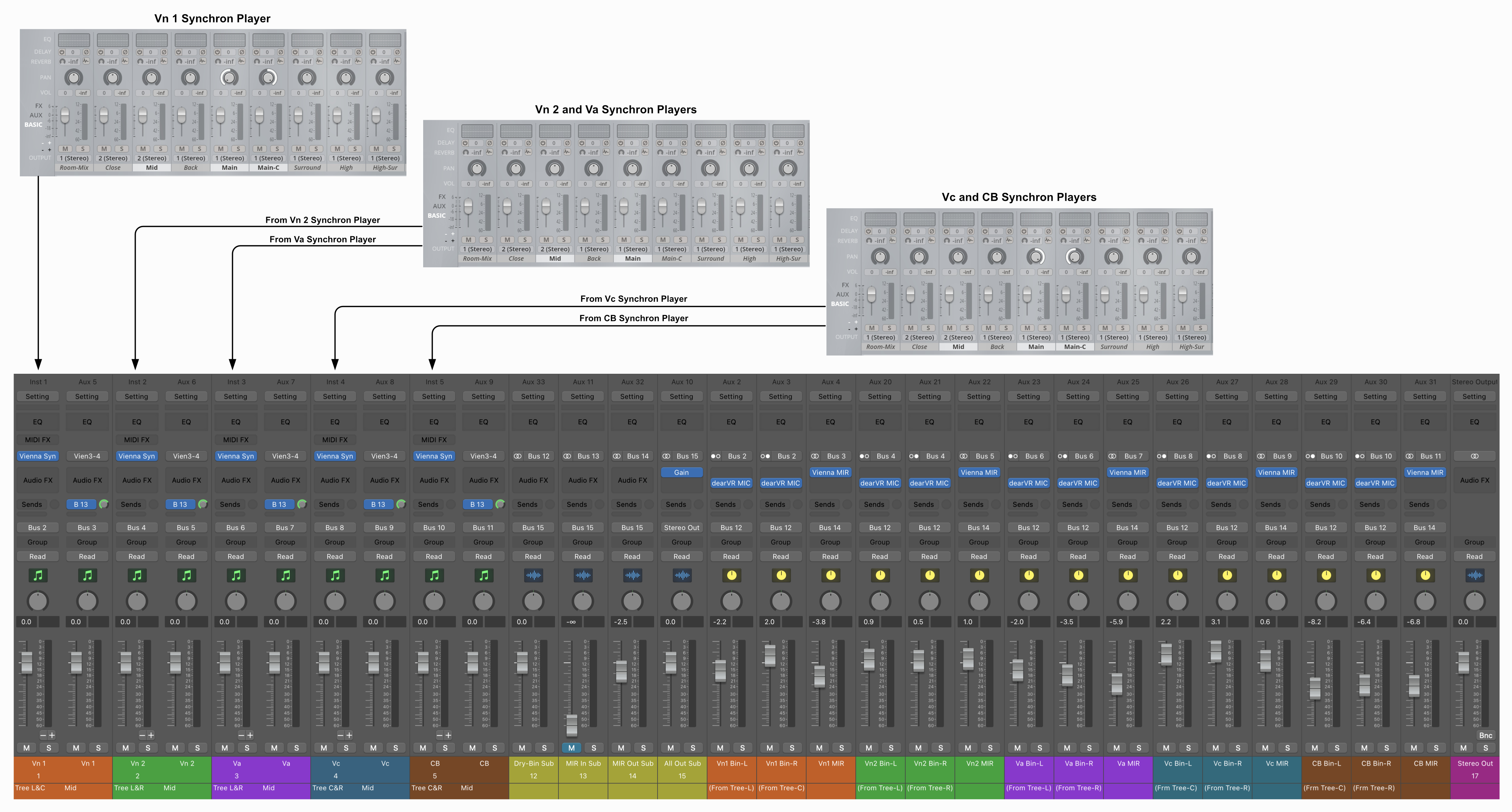Here's a get-you-going headphone mix setup for Synchron Strings Pro and MIR in Logic Pro. For each string section the dry(-ish) location and width on stage are produced by two binaural panners; while separately, a wet-only 2-dimensional HOA ambience is produced in MIR. The wet and dry stereo fields are then simply summed by Logic. The two binaural panners work together to exploit the unique properties of the Decca Tree in Synchron libraries.
Why do it this way? It's specifically for placing richly-wide and well-located dry(-ish) binaural sound images of large Synchron instrument sections anywhere on stage without involving MIR (because MIR cannot binauralise its channels); while at the same time but on separate wet-only paths, using MIR's unique ability to produce located 2D and 3D ambience images using its 'ambisonically-enhanced' IRs.
For me at least, it's the best result I've ever been able to achieve in terms of adding wet-only spatialised ambience on top of stage-wetted-only binaural locations and widths, for large Synchron instrument sections. If anyone has been able to achieve the same sort of results using only MIR in the normal way, please show us how - or at least post an audio demo.
For single instruments and small ensembles there is little if any advantage in using this unorthodox approach, since in these cases the dry (or lightly stage-wetted) image is not required to be spatially extensive. For these cases MIR can be used in the normal way for both dry and wet signal paths, alongside the unorthodox separated dry and wet paths approach described here for use with large Synchron instrument sections. But of course if you're already satisfied with the sound images you're achieving with large Synchron instrument ensembles (perhaps also with MIR used in the normal way for both dry and wet imaging), then this exercise is probably not for you.
There's no need here for the DearVR Monitor plugin. Several instances of the free DearVR Micro binaural panner plugin are used, which I much prefer compared to Logic's built-in binaural panners. (It's also possible to set up Logic for Dolby Atmos and use the Atmos Object panners for this purpose, but that's another story.)
3D dry location is also possible (within certain limits) for this setup, but in this example I've set up a concert-hall performance in which height is not especially relevant.
Stage Locations (intro) - with reference to the pictures in Attachment 1 - "Synchron and MIR Stage Plans"
For this case I've chosen to use a stage plan similar to an unusual one used by Berliner Phil, in which only Violins 1 are in the same(-ish) location as recorded by VSL in Synchron libraries. Below, I describe how I've applied binaural location and width to each string section separately, including Violins 1.
Observing the standard Synchron stage plan and the position of the Decca Tree, for purposes of dry binaural panning it seems (and sounds) best to use Left and Centre Tree mics for Vn1; the Centre and Right Tree mics for Vc and CB; and the Left and Right Tree mics for Vn2 and Va.
The Mixers - with reference to the pictures in Attachment 2 - "Synchron and Logic Mixers"
In Synchron Player
In each of the 5 Synchron players inserted in Logic, having selected the relevant string section, go to the MIXERPRESET tab and activate the "default" factory preset. Then set up each of the string section mixers as shown in Attachment 2. (Please be careful not to overlook the OUTPUT setting for each activated mic.)
In Logic
Apply the setup for Logic's mixer as shown in Attachment 2. (Note the reversal of mono-input selections in the aux track pairs for Vc and CB.)
MIR Plugins Setting: All set to 100% Wet
DearVR Micro binaural panner plugin settings (Revised 31st Oct.):-
Preliminary settings in all instances of the DearVR Micro plugin:-
- HRTF: DearVR
- Elevation: 0°
- Reflections: Off
- Focus: 100% (HRTF) (For a subsequent loudspeaker mix, this setting can be reduced to alleviate any unwanted mixing of psychoacoustic cues due to loudspeaker crosstalk.)
- Width: 0% (Whilst adding width may sometimes seem to be beneficial when listening to an instrument in solo, in a busy mix I'm currently preferring all width settings at zero.
Azimuth settings in each DearVR Micro panner (get-you-going values only, you can do better!):-
- Vn1 Bin-L: -48°
- Vn1 Bin-R: -10°
- Vn2 Bin-L: 10°
- Vn2 Bin-R: 48°
- Va Bin-L: 4°
- Va Bin-R: 24°
- Vc Bin-L: -24°
- Vc Bin-R: -4°
- CB Bin-L: -30°
- CB Bin-R: 30°
Each pair of binaurally-panned aux tracks need to be mixed together carefully by ear to produce the best sounding combination of azimuth and width. And this is where interactions between the settings of each of the two binaural panners and their relative levels (even a 0.1dB change may make a discernible difference) can lead to much rabbit-hole exploration!
Stage Locations in MIR - with reference to the picture of MIR in Attachment 1 - "Synchron and MIR Stage Plans"
Alas, we now have to set up stage locations and widths again, this time in MIR for wet-only ambience. In this case we're operating on Synchron's Mid mics, fed only to MIR. And just as Dietz recommends that feeding MIR with a stereo image is beneficial for MIR ambience, Synchron's MId mics do seem to lead to better sounding MIR ambience, compared to using the mono Close mics.
The picture of MIR shown in Attachment 1 shows the locations and widths for each string section that match up fairly well with the corresponding dry locations and widths produced by the binaural panning detailed above - but here again, you can do better!
I know it's a lot of extra work compared to using MIR in the normal - and very convenient - way. I guess I'm like the guy who went to his doctor complaining that he always seemed to do things the difficult way; long story short, the doctor finally asked him "So ... how do you make love with your wife?", to which the guy replied "Well ... have you ever tried standing up in a hammock?"
Happy mixing! Trust your ears - and allow yourself plenty of time to develop intuitive skills where needed!
Audio Demo (Revised 31st Oct.) - Attachment 3
First 132 bars of the Scherzo in Tchaikovsky's 4th Symphony.
I suggest you listen with eyes closed. I've used no automation anywhere except for Vel.XF on each string section merely to follow the score. The instrument sounds are all factory default, straight out of the box. No EQ or Fx have been added anywhere. All of the dramatic apparent 'panning' shifts going on in realtime are due solely to Tchaikovsky's buoyantly burlesque bounding around the string sections!

